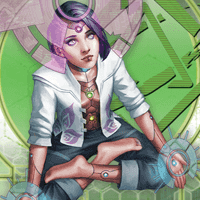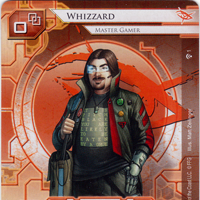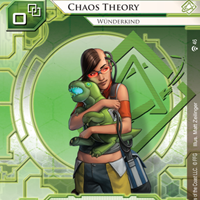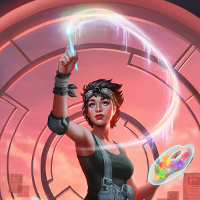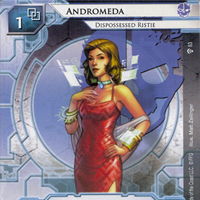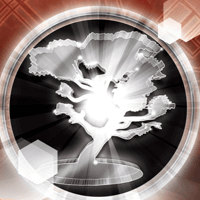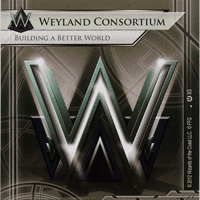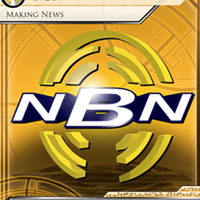In this article we will be taking a look back at the meta of Spin Cycle and see how the Corp and Runner IDs stacked up after the release of Double Time right before Honor and Profit came out. We have taken a poll of various well known and strong players within the greater Netrunner community to examine what ID’s were considered strongest at the end of the Spin Cycle meta. By looking at the relative rankings of the various IDs, we hope to get a good impression of how players felt the meta looked.

The Runner Rankings: Spin Cycle
Tier A: Andy, Gabe, Kate
Tier B: Chaos Theory, Whizzard, Kit
Tier C: Reina, Noise, Exile
Tier F: Professor
| Rank | Hollis | Genestealers | Orange Devil | General_Norris | running_bear |
|---|---|---|---|---|---|
| 1 | Andromeda | Gabe | Andromeda | Kate | Kate |
| 2 | Gabe | Andromeda | Kate | Chaos Theory | Andy/Gabe |
| 3 | Kate | Kate | Gabriel | Kit | Gabe/Andy |
| 4 | Chaos Theory | Whizzard | Chaos Theory | Andromeda | Whizzard |
| 5 | Kit | Chaos Theory | Kit | Gabriel Santiago | Chaos Theory |
| 6 | Exile | Noise | Exile | Whizzard | Reina Roja |
| 7 | Noise | Professor | Noise | Noise | Exile |
| 8 | Whizzard | Exile | Whizzard | Reina | Kit |
| 9 | Reina | Reina | Reina | Professor | Noise |
| 10 | Professor | Kit | Professor | Exile | Professor |
| Rank | Alexfrog | hoobajoo | Hobb | Tuism | Jamieson |
|---|---|---|---|---|---|
| 1 | Andromeda | Gabe | Andromeda | Gabe | Kate |
| 2 | Gabe | Kate | Gabe | Andromeda | Andromeda |
| 3 | Kate | Andromeda | Kate | Reina | Gabe |
| 4 | Kit | Chaos Theory | Kit | Chaos Theory | Kit |
| 5 | Exile | Whizzard / Reina | Chaos Theory | Kate | Chaos Theory |
| 6 | Chaos Theory | Reina / Whizzard | Exile | Whizzard | Exile |
| 7 | Reina | Kit | Whizzard | Noise | Noise |
| 8 | Whizzard | Noise | Reina | Kit | Whizzard |
| 9 | Noise | Professor | Noise | Professor | Reina |
| 10 | Professor | Exile | Professor | Exile | Professor |
| Rank | teh_exile | Scott Awesome | Tim Bunn | Mediohxcore | Asroybal |
|---|---|---|---|---|---|
| 1 | Gabe | Andromeda | Gabe | Gabe | Kate |
| 2 | Andromeda | Gabe | Andromeda | Andromeda | Andromeda |
| 3 | Kate | Kate | Kate | Kate | Gabe |
| 4 | Chaos Theory | Chaos Theory | Noise | Whizzard | Reina |
| 5 | Exile | Reina | Reina | Chaos Theory | Kit |
| 6 | Reina | Kit | Kit | Reina | Noise |
| 7 | Kit | Whizzard | Whizzard | Noise | Whizzard |
| 8 | Noise | Noise | Chaos Theory | Kit | Chaos Theory |
| 9 | Whizzard | Exile | Exile | Professor | Professor |
| 10 | Professor | Professor | Professor | Exile | Exile |
The Spin Cycle Runner Power Ranks
#10: The Professor

Avg Ranking: 9.46
Best Rank: 7
Worst Rank: 10
Analysis By: Mediohxcore
One thing that everyone can agree on is that this guy has nowhere to go but up! The Professor’s ability lends himself to a toolbox-style deck, utilizing Shaper staples Test Run and Self-Modifying Code to easily locate programs to best answer the current board state. Unfortunately, there are not quite enough powerful, high-influence Criminal and Anarch programs to balance out the Prof’s disadvantages, namely, inconsistency and the inability to splash Desperado or Account Siphon.
Slowly, the Prof is going to gain more and more ground on his Shaper brothers and sisters. Each time a card like Keyhole, Morning Star, Faerie, or Sneakdoor Beta is printed, he will gain a little more ground, as Kate and friends find themselves unable to splash all the sweet programs they would otherwise like to. Eventually, it is thought that there will be enough of these powerful out-of-faction programs to make the Professor a more legitimate option. That’s not to say you can’t win with him now, though! Since the release of Keyhole in particular, the Professor has put up a couple of respectable small-tournament placements, including his very first publicized tournament win.
Power level aside, it’s a great mental exercise to play with the Prof. Huge decision trees, a dynamic rig, and an absurd amount of tricks make playing him as rewarding as it is difficult. He might not be the best ID, but he’s certainly in the running for the most fun.
#9: The Exile
Analysis By: DB0
The Exile, like the Professor is an easy runner to dismiss as too gimmicky for competitive play, especially since most players who attempt to make a straightforward Exile deck quickly discover that simply swapping “Mac” in, instead makes the deck perform actually better due to the inherent consistency of the credit discount, compared to the extra card when dumpster diving.
But Exile is not a straightforward runner and he tends to suffer from straightforward decks. One instead needs to think of Exile as tool for combo-making and attempt to play to such strengths. The classic example is the Exile – Pawn – Shehrazade – Deep Red combo. At first glance, this Spin-Cycle-powered monstrosity seems absurd, using 4 cards to achieve what criminals easily get with a Desperado and a Masanori. But as many corps on the other side of it have found out, it provides some surprising defenses and pressure in areas one did not expect to focus.
Unfortunately, even though Creation & Control is what provided the most required tools for living in the streets, Spin Cycle has not really delivered a wealth of pieces to constantly recurse with the notable exception of Sharpshooter and the previously mentioned Pawn combo. Most Exiles do not care a lot about double events, and while the proliferation of Bad Publicity can support homeless economics, this cycle has been fairly poor on things with which to synergize. However even non-Caissa loving Exiles get a huge benefit from running Scheherazades which makes his frequent recursions a very affordable business indeed. So while one cannot say Spin Cycle as a whole has been amazing, it has provided a few crucial pieces to make Exile decks more competitive.
In the end, underestimation and surprise is the name of the game when it comes to people sitting against Exile and its something one needs to capitalize on. A Corp facing off against Kate or Gabriel, knows more or less what to expect, but against an Exile, all is up in the air.
And an uncertain corp is an easier corp.
#5: Whizzard
Analysis By: Genestealers
For a while Whizzard has been the redheaded cousin to his bigger meaner fellow anarch Noise, but Jackson Howard showed up and made lots of distracting toys which seem to have completely taken Noise out of his game. However the “Master Gamer” Whizzard knows how to deal with the toymaker.
The recurrent 3 credits that come on the Whizzard ID for trashing are extremely strong in the current meta, with asset economy making a huge comeback in several decks. First every corporation deck has at least 2 of Jackson, which seems almost tailor made for the master gamer using his recurring credits and not a credit more. Secondly quite a few of the strongest decks at the moment use SanSan City Grid as a huge tax on the runner as well as a way to quick score agendas from hand. Whizzard has that covered too. “Costs the Corporation six to rez? Sure I will spend two credits to burn it down.”
His ID ability leads to a very economic heavy battle which makes strong use of account siphon as well as vamp to get the corporation poor and keep them poor while he makes smart accesses with medium and nerve agent slowly gaining strength, because if there is anything the master gamer is good at, it is creating inevitability.
However, Whizzard suffers from the same problems that all anarchs currently have. Little in faction economic solutions, no tutors, and no card draw. So if you want to go with the strong economic warfare solution for Whizzard, you are going to have to do it without Special Orders, Clone Chips, Aesops or Opus.
Despite those weaknesses Whizzard is quite strong in the current asset heavy meta grinding corporation after corporation into bankruptcy by using his strengths smartly and giving the corporation no chance to recover
#4: Chaos Theory
Analysis By: SneakySly
Chaos Theory had a pretty decent showing during the Double Time tournament scene and during the Chronos Protocol Tour. Performing just under Kate, Chaos Theory provided an alternative way of playing Shaper, albeit one that often relied on the raw power of a consistent Account Siphon.
With a lower deck size allowing for increased consistency, Chaos Theory allowed many players to pack the double threat of multiple Siphon and Indexing. In tandem, this allowed Chaos Theory to easily exploit any temporary central server weakness with a powerful attack.
#3: Kate
Analysis By: Lysander
From the onset of Spin Cycle, Kate has seen the sharpest increase in winrate of any ID on either side of the cyberwar. Favored by new players and veterans alike, Kate embodies versatility incarnate with no signs of slowing down. From the moment the identity hits the table, the Corp must immediately plan for a myriad of contingencies, from aggressive tactics such as Account Siphon and Indexing to preventing a complete lockout from control tactics provided by Atman and powerful (albeit expensive) breakers.
Regardless of her means, Kate’s ability helps her hit the ground running, saves a lot of credits over the course of the game, and enables otherwise ill-advised cards and strategies, such as Prepaid VoicePAD. Self-Modifying Code and Clone Chip bolster consistency and reliably filter and recur icebreakers and viruses, allowing her to maintain aggression and prevent the Corp from opening up scoring windows. With such tools, Datasucker and Parasite find ample synergy and utility in most archetypes with enough room to spare for the best Criminal tricks on the market.
Throughout Spin Kate has received further assistance from tools such as Sharpshooter and Inti which, while unimpressive on paper, assist against many of the top competitive Corp tools. H&P further supplements her arsenal, allowing her to spread her influence further with cards such as Planned Assault. Provided Jinteki enters the competitive fray, Kate’s arsenal will increase in demand even further.
Though perhaps not as flashy or domineering as her Criminal counterparts, Kate has proven that against an increasingly diversified field of Corporations, she alone has all the answers, provided you prepare her for it, and no matchup is overwhelmingly against her. However the meta may shift, her future seems extremely bright.
#2: Gabe
Analysis By: Genestealers
Gabriel Santiago – CONSUMMATE professional.
con·sum·mate – adjective – showing a high degree of skill and flair; complete or perfect.
If there is one word to sum up the playstyle of a properly built and piloted Gabe deck, that would be consummate. Gabe is the most hyper aggressive of all the runner identities encouraging the playstyle of “run early, run often” that the game designers say is their best advice to a new player. With a multi-server attack strategy a corporation that sees Gabe across the table knows that their HQ will be under assault almost immediately, followed closely by an assault on Archives due to Sneakdoor Beta synergizing so well with his identity. Often Gabe will randomly snipe an agenda through repeated accesses into HQ making it extremely difficult for the corporation to hide an agenda there. If both HQ and archives are protected, Gabe can just switch to R&D running due to desperado making his runs more efficient. Even if the corporation has all three central servers locked down, the current Gabe deck can compromise any remote server fairly simply with a combination of Inside Job and Knight.
Speaking of knight, that card addition to the toolbox of Gabe has caused Gabe to rise from his former position of mid pack runner to his current rating of just barely behind Andromeda. Knight allows Gabe to apply a tremendous amount of pressure by straight up compromising any one ice server just with its presence on the table, and threatening any two ice server when combined with inside job. So the corp knows that it really needs to go three ice deep on a remote to begin protecting it. The game turns into “can the corp get three ice up before Gabe gets his breaker suite online” which often is far more beneficial to the Gabe playstyle where he wants to “run early and run often” on the centrals. The always strong criminal events such as special order and account siphon can be leveraged to give Gabe the momentum he often needs to score those last agendas.
The weakness of Gabe comes into focus if the corporation can get to the late game however. With all three centrals iced two or three deep, and a secure remote established, Gabe tends to run out of steam as his runs become less and less efficient. Often the Gabe game tends to be one of “can Gabe score enough agendas to win before the corp locks him out” due to his ability to extend the early and mid game. Even the mitigating factor of Kati Jones doesn’t save Gabe from running out of steam.
All in all, running a Gabe deck in the Spin Cycle meta is a lot like skydiving. Very fast and exciting, but you better have your win condition in time or else you are going to hit that big round wall looking thing really hard.
#1: Andromeda
Analysis By: Mediohxcore
As the Spin Cycle comes to a close, Andromeda’s claim to the runner throne is no longer what it used to be. Since her dominating performance at Worlds in the Fall, the playing field has been somewhat leveled between her and the other top-tier runners. First, Gabe got access to Knight, which helped him catch up on the consistency front, as he can no longer be locked out of HQ or a fast remote server as easily. Then, the release of Sweeps week in the most popular corporation faction meant that Andy no longer could count on an enormous head start. Finally, some new players emerged in the metagame who have found ways to deal with Andy’s unyieldingly efficient, yet fragile, breaker suite.
Gozik’s stellar performance in OCTGN league with a Power Shutdown-centered Jinteki PE deck made a lot of waves. Power Shutdown anywhere is a huge threat against the breaker-light Andy decks, but the combination of Power Shutdown, Net Damage, and Destroyers were found to be a deadly combination against her cheap pieces like Faerie, Datasucker, and Corroder. Soon afterwards, Nordrunnner publicized his “Red Coats” HB Glacier deck, which uses high strength code gates like Viktor 2.0 and Tollbooth, and other multi-subroutine ICE like Caduceus, Eli 1.0, and Heimdall 1.0 in conjunction with Ash. Against this sort of deck, Andy can have issues finding enough cash and Datasucker tokens to repeatedly break ICE and trash the corp’s powerful Assets.
Despite all of this, Andy still stands strong in the meta. Her 4-card head start still makes her the most consistent runner in the game, even if that consistency doesn’t translate into a win as often as it used to. She still has a dominating game against Weyland Tag & Bag decks, and might claim the best NBN matchup despite the release of Sweeps Week. However, unlike six months ago, players looking to maximize their winning chances might want to consider the metagame before immediately defaulting to Andy.
The Corp Rankings: Spin Cycle
Tier A: Making News, TWIY, ETF
Tier B: HB:CI, Weyland: BABW, GRNDL
Tier C: Jinteki: RP, Jinteki: PE, HB: NEXT
Tier F: HB: CB, HB: ST, Weyland: BWBI
| Corp Rankings | Hollis | Genestealers | Orange Devil | General_Noris | running_bear |
|---|---|---|---|---|---|
| 1 | TWIY | TWIY | HB: ETF | HB: ETF | NBN: MN |
| 2 | MN | ETF | NBN: TWIY | NBN: MN | NBN: TWIY |
| 3 | ETF | CI | NBN: MN | NBN: TWIY | HB: ETF |
| 4 | CI | MN | HB: CI | W: BABW | Weyland: BaBW |
| 5 | BABW | BABW | W: BABW | GRNDL | HB: NEXT |
| 6 | GRNDL | GRNDL | J: PE | J:PE | Weyland: GRNDL |
| 7 | PE | PE | W: GRNDL | HB: CI | HB: CI |
| 8 | RP | NEXT | J: RP | Jinteki RP | Jinteki: PE |
| 9 | NEXT | RP | HB: NEXT | HB: NEXT | Weyland: BWBI |
| 10 | HB: CB | BWBI | W: BWBI | HB: Custom | Jinteki: RP |
| 11 | ST | ST | HB: CB | HB: Weaker | HB: ST |
| 12 | BWBI | HB: CB | HB: ST | W: BWBI | HB: CB |
| Corp Rankings | Alexfrog | hoobajoo | Tuism | teh_exile | Jamieson |
|---|---|---|---|---|---|
| 1 | TWIY | MN | NBN: MN | NBN:TWIY | MN |
| 2 | MN | GRNDL | HB: ETF | W: BABW | TWIY |
| 3 | CI | TWIY | NBN: TWIY | NBN: MN | NEXT |
| 4 | BABW | ETF | W: BABW | HB: ETF | CI |
| 5 | ETF | BABW | J: RP | W: GRNDL | ETF |
| 6 | PE | PE | W: GRNDL | HB: CI | GRNDL |
| 7 | GRNDL | CI | HB: CI | J: RP | BABW |
| 8 | RP | RP | J PE | HB: Next | PE |
| 9 | NEXT | NEXT | HB: Next | HB: CB | RP |
| 10 | CB | BWBI | HB: CB | J: PE | CB |
| 11 | BWBI | CB | W: BWBI | W: BWBI | BWBI |
| 12 | ST | ST | HB: ST | HB: ST | ST |
| Corp Rankings | Tim Bunn | Scott Awesome | Mediohxcore | Asroybal | SneakySly |
|---|---|---|---|---|---|
| 1 | MN | TWIY | MN | NBN: MN | NBN: MN |
| 2 | CI | MN | EtF | HB: ETF | NBN: TWIY |
| 3 | GRNDL | CI | CI | HB: CI | HB: ETF |
| 4 | BABW | BABW | TWIY | W: BABW | HB: CI |
| 5 | ETF | ETF | PE | NBN: TWIY | W: BABW |
| 6 | PE | Jinteki tie | BaBW | J: PE | W: GRNDL |
| 7 | RP | Jinteki tie | RP | HB: Next | J: PE |
| 8 | TWIY | GRNDL | GRNDL | W: GRNDL | J: RP |
| 9 | CB | NEXT | NEXT | J: RP | HB: NEXT |
| 10 | NEXT | BWBI | CB | HB: CB | HB: CB |
| 11 | BWBI | CB | BWBI | W: BWBI | W: BWBI |
| 12 | ST | ST | ST | HB: ST | HB: ST |
The Spin Cycle Corp Power Ranks
#12: HB: Stronger Together
Analysis By: Jamieson – Bad Publicity
If you have ever tried a Stronger Together deck you have probably asked yourself one question after a few turns into the game; “Why am I not running this exact deck with Engineering the Future!” At least if you did you would be able to install and Rez more ICE. Economy is a linchpin in a Haas deck. Take this away and watch it fall and crumble to any runner. Not to say that every corporation doesn’t need money, they just don’t need as much as a Bioroid deck. This ID is probably the most unpopular choice if you are playing purple.
Bioroid has BIG taxing ICE that is expensive to rez and only really sees true benefit when stacked in sec-session. If you are able to do this it means you’re probably just passed the “early game” phase or you hit some lucky card draws for money and Bioroid Efficiency. There is definitely a good amount of Bioroid ICE to take advantage of this ID but there is not enough cheap Bioroids. Looking for that baby Bioroid end run but I think this would negate everything that is Bioroid.
The deck that this ID would be helm would look more along the lines of a runner taxer. You want to lead the runner through long costly dives into a server so everything in the deck has to complement that theme. Draining their credits and then planning a quick counter strike the turn after.
Another untimely thread that unwinds this deck is that big breakers are on the comeback. Morning Star is becoming more popular among choice for a Fracter these days. Not to mention E3 is coming around again also. And if there is ever a card that can eat through Bioriod ICE like a tender steak it’s E3 Feedback Implants. Paying a click and a couple credits and suddenly the strength of that ICE is meaningless.
Somethings you just need to look around and see that there is a reason no one is playing this over every other HB choices. I’m not saying all this to discourage you I love to see diversity in the game and would love more people to play the unsung ID’s. But its not competitive ready yet. And hey someone had to write about the unpopular picks. Give it a try and you too just might ask yourself “Why am I not running this exact deck with Engineering the Future!”
#11: Weyland: BWBI
Analysis By: Genestealers
Those words once held promise, the dream of an ice wall stretching from here to the moon keeping all runners away from your servers. The box ability is worth basically one free credit every turn which should make it one of the strongest abilities in the game, as the HB ability is commonly considered to be the best. Also if you create a monster ice wall you can commercialize it turning your ID ability directly into a money making machine! Huzzah!
There are several problems with making the dream a reality. First you have to get an advancable ice on the table in a position that it is actually useful to start advancing it on. A shadow on R&D is not an ice you want to start advancing. A Woodcutter or Tyrant both need to be rezzed before you can start putting counters on it, and the strength of both those ice is greatly diminished when the surprise factor is lost, with woodcutter also being supremely vulnerable to parasite.
All is not lost however, as if you can secure your centrals and then get out an ice wall on a remote with Simone Diego in the back, you can add 3 strength to an ice wall for free every turn until your opponent cries tears of anguish. Until they Femme it. NOOOOOOOOOOOOOO!
All in all, BWBI would be amazing if you could put the tokens on unrezzed ice that otherwise would not be able to be advanced (like the Tennin Institute). BWBI would be better with more advancable ice in some distant nebulous future.
#10: HB: Custom Biotics
Analysis By: SneakySly
Poor Custom Biotics suffers from similar problems as The Professor. An ability that just affects influence instead of actual gameplay mechanics leaves a lot to be desired. Additionally, because CB is all about the out of faction cards, your opponents will know to be wary of things like Scorched Earth and play accordingly. If assembling some combo of high influence cards becomes very powerful then this ID could actually see some more play, but as of Spin Cycle there is a good reason why CB has yet to win any tournaments.
#9: HB: Next
Analysis By: Mediohxcore
Since it’s release, NEXT design has gotten people excited. After all, it is the closest corp ability to Andromeda’s, and she’s a top-tier runner! So what is it exactly that’s keeping NEXT design closer to the bottom end of the corp spectrum?
The first offender is the competition. EtF’s ability is just so damn good for any strategy, be it fast advance, big ICE, or brain damage, and the extra influence is far from trivial, even in the faction which probably relies on outside help the least. If you want to build a NEXT deck that wouldn’t just be better as an EtF deck, you’re going to have to go rush to take full advantage of the head start. Unfortunately for NEXTers, it has become apparent that even with a huge pile of cheap ICE like NEXT Bronze, Quandary, and Paper Wall, rush decks can’t seem to move fast enough to score 7 points in remote servers faster than the average runner can compromise those servers. The main options for rushers are either to back up their rush with fast advance or a flatline threat.
Considering the flatline threat isn’t a terribly viable option in an HB identity with only 12 influence, and you’re probably too poor to rely on Biotic Labor after filling your deck with ICE, the most viable option is to rush Efficiency Committee and fast advance with Shipment from SanSan. In the past, this strategy has proven to be somewhat unreliable, as you’re unsure to see your Committees fast enough, and you still have to defend R&D lock to some degree. However, with the release of Fast Track in Honor and Profit to help you find your Committee, it’s possible that it’s time to give NEXT rush another try.
#8: Jinteki: RP
Analysis By: DB0
It has always been hard to replicate perfection, ever since it came out early in the Genesis cycle. Jinteki has always been lacking in efficient ICE and the designers’ expected victories through mind-games never seemed to materialize in the competitive scene. As such Jinteki:RP has been trailing far behind its older and nastier brother, having neither the damage potential, nor the influence required to import enough economy and ICE to make its ability worth it. Many players cried out in frustration as they glimpsed at the untapped potential.
With Spin cycle however, things quickly started turning around for the lovable underdog. The arrival of Sundew, a super-efficient economy, seemingly custom-made for replication, allowed the identity to spread it wings and finally afford the shenanigans it needed to pull. That, combined with Celebrity Gift immediately solved the riddle of where to find the influence for both imported Economy and ICE. Now perfectionists everywhere could rub their hands with glee as synergistic and non-Mimic/Yog-bait favorites like Ichi 1.0, Tollbooth and Hourglass could finally be afforded and paid for. Not only that but Spin cycle finally provided enough useful Jinteki and Neutral ICE such as Grim, Tsurugi, Yagura and Hitsumi-Bako, that there was even enough influence left over to start importing expensive synergistic Upgrades such as Ash and Ruhr Valley.
But of course for most players, the big break came when Caprice Nisei herself landed, and the click pressure turned to 11. Ever since then, Jinteki:RP decks have started getting far more experimental playtime in OCTGN as well as meatspace tournaments, even winning their fair share, with one highlight being my own almost-undefeated run with the Untrashable archetype landing me in 2nd place at the 5th OCTGN League.
Perfectionism is still a tricky business, demanding very experienced pilots with unorthodox play-styles, and many top players still scoff at the claims that RP deserves a spot among the A-list corps. But like the nosies Making News, Replicating Perfection allows for a lot of deckbuilding possibilities and I’m confident we’ll be seeing more and more of them at the top challenging the accepted paradigm.
#7: Jinteki: PE
Analysis By: SneakySly
While Jinteki had a much more difficult life prior to Honor and Profit, it was not completely hopeless. Power Shutdown gave some life to an otherwise bleak and difficult to play ID, allowing the Shutdown Jinteki deck to pose a challenge. Being able to threaten programs both in play and in the Grip gave Personal Evolution a new gameplan that could focus around eliminating key runner cards like Corroder and exploiting the runner’s weakness.
Still, even with new cards like Shock!, Tsurugi, and Power Shutdown, Jinteki was easily the weakest of the four corporate factions, and was in dire need of Honor and Profit to give them a needed boost.
#6: Weyland: GRNDL
Analysis By: Hoobajoo
Geostrategic Research and Neothermal Development Laboratories
That acronym is pretty great, isn’t it? Almost as good as this ID is! I’m shocked, SHOCKED, that I seem to be the only person that rates this higher than the Core ID. And at face value, you might think like that: after all, BABW typically will give you five extra credits, maybe less maybe more, and it doesn’t come with a Bad Publicity or a lower influence count. But critically, very critically, this money comes on turn ZERO. BABW might give you six credits later, on a good day, but GRNDL gives them to you right from the start! You hit the ground running, and don’t stop until you’ve crossed the finish line. And come on, you’re Weyland, were you really not going to take bad pub at some point?
Let’s talk about that, actually. Much of my love for a reckless, speedy Weyland came when I realized that given a long enough time frame, the runner WILL win. And not because of decking, but the corp’s economy is either single-shot operations or trashable assets. This means that the runner has a much more secure, bluntly powerful economy, so the corp can’t wait, and once a rig is fully built, a good runner can cut through anything. So I resolved to win before the runner COULD build a rig! Bad publicity is meaningless in this deck; before a runner can get through your 3-ICE remote, it doesn’t matter how many fake credits they can’t spend, and once they can, well, you’ve lost no matter how many bad pub they have.
I really can’t overstate the power of those five credits. Of course it lets you easily run Restructure, which BABW finds significantly more clunky. It makes an early flatline threat much harder for the runner to play around. And maybe most importantly of all, it lets you score your first agenda probably a turn earlier. Given how well all of Weyland’s agendas snowball into one another and build tempo, this is a big impact. The fact that all those initial credits come not only at once, but irrespective of your draw, means GRNDL performs more consistently than BABW, which is often dead in the water if it doesn’t get a couple transactions.
The only knock against it really is the lower influence. I know Lucas said they could have made GRNDL have 12 influence, but I disagree; that would be an objective power-up to Weyland without giving up space for it’s tagging package. As it stands, it is a legitimate trade off, but one I am glad to make for the extra power and consistency GRNDL promises. This influence gap will become less of an issue as the game goes on, and if Weyland ever gets it’s own card draw effect or tagging operation, it’s game over, man. Game over.
#5: Weyland: BABW
Analysis By: SneakySly
While Weyland: BABW was a very large part of the meta for most of the Spin Cycle, by Double Time Weyland’s presence had dropped significantly. In Fear and Loathing BABW accounted for 17.8% of the tournament winning decklists, but in Double Time they took a big drop down to 6.9%.
Despite it’s less popular position BABW still remains a deck that is more than capable of winning tournaments. The existence of BABW alone still accounts for most players running Plascrete Carapace in their decks to ward off Scorched Earth. While new powerhouse agenda NAPD Contracts does not work well with Weyland favorite Hostile Takeover, Hive was a powerful new card that can greatly help with scoring a Project Atlas early in the game.
#4: HB: CI
Analysis By: Mediohxcore
What was once decried as the worst Corp ID in the game is now being recognized as a sleeping powerhouse. Celebrity Gift, Restructure, and Blue Level Clearance now mean that Cerebral Imagineers not only have a critical mass of econ operations to power their remote-less decks, but that they have options for which of these cards to include. It didn’t take long for 4x Biotic or Efficiency Committee/Shipment from SanSan decks to come out of the woodwork, and the pilots of these decks soon realized that they were anything but a novelty.
CI decks have a careful balancing act in deckbuilding to gain early HQ/R&D defense and enough money to get the ball rolling on a large hand. However, once they land their setup, they become some of the more consistent Corp decks in the game. The runner finds herself struggling for random accesses and crossing their fingers, and with a little bit of luck, CI can Fast Advance all the way to 7 before the runner can get there. Multi-Access, Sneakdoor, and ICE destruction, and credit denial can be issues for CI, but it definitely has the tools to power through, especially if the runner has a stroke of bad luck picking random cards out of humungous hands.
Thankfully, Imaging got a couple of brand new toys in Double Time to help it combat the tricky runners. Hive is one of the few things that can compete with Celebrity Gift for influence, providing an absurd amount of taxing subroutines for the vast majority of the game. Reclamation Order can not only supplement or replace Archived Memories and/or Jackson Howard, but also potentially power absurd 7-point combo turns in conjunction with Power Shutdown, Accelerated Diagnostics, and Efficiency Committee/Shipments. It remains to be seen how legitimate each of the CI variations are, but it’s safe to say there exists a high-tier list for anyone willing to work to build it.
#3: HB: ETF
Analysis By: Mediohxcore
A behemoth since the inception of the game, Core HB still sits near the top of the corporations. Why shouldn’t it? A free credit every turn compares very favorably with the abilities of Making News and Building a Better World, and you don’t need to work very hard to get it. The flexibility of that free credit has shown itself to be incredibly useful, not just for the old-style HB Fast Advance decks, but also the up-and-coming HB Glacier decks. HB also has free access to the incredibly taxing cast of Bioroid ICE, who not only help set up absurdly expensive servers to house Caprice and Ash, but deny the runner efficient R&D lock if you’re trying to fast advance like the good old days.
It might be hard to compete with the Astroscript/SanSan combo when it comes to fast advancing, but thanks to a multitude of awesome ICE and economy options in faction, EtF can painlessly import both SanSan and Jackson Howard into fast advance decks. Their ICE is also very strong for taxing, (even without free trace credits), and being able to play more ICE than NBN because of the free credit allows HB to make up what it lacks in Astroscript counters with unmatched consistency. Even if Biotic Labor isn’t enough to have kept HB the king of fast advance over the course of the spin cycle, no one denies that HBFA is still a totally valid competitive strategy.
HB Glacier decks are also starting to make their presence known, thanks in large part to Nordrunner, who developed and presented his version ,“The Red Coats”, on BoardGameGeek. It turns out that scoring 5/3s in remote servers can be a totally tournament-valid if they can be protected by a combination of protection upgrades and huge Bioroids. The extra money for installing becomes awesome when you plan on building ICE towers, running nauseating beta tests, and installing asset economy like Eve and Adonis Campaign. It’s possible that this style of deck is even more powerful than the obviously-tier-one Fast Advance decks, but even if it’s just on par, having a second high-power archetype means that EtF is probably going to stick around at the top of the metagame for a while.
#2: TWIY
Analysis By: Genestealers
What is that sound? The one that sounds like it is getting closer? Man that is really getting close and it sounds like WTF I JUST GOT HIT BY A TRAIN.
That is right, NBN brings the pain train and no deck does it faster than TWIY. Astroscript is the best agenda in the game. Literally no one disputes that fact. TWIY brings several things to the table that help you leveredge that asset into a victory. First, being able to slim your corp deck down to 40 cards allows you a higher percentage of drawing your astro when you want it (also when you don’t want it but thems the breaks). Secondly the increased hand size gives a slightly higher chance of keeping your agendas safe in your hand. Combined with in faction SanSan City grid, strong economic options sweeps week and shipment from SanSan letting you jump out to an early credit lead to pay for those Biotic Labors that seem to enable this deck like The Fonz enables juke boxes. Add to that one of the best ice packages in the game to support a rush strategy with wraparound and popup window for early taxing and even more economy there is little that can stop this astro train from getting a rollin. In faction card draw with Jackson Howard, Anonymous Tip and Corporate Shuffle make it so that you get what you want when you want it. There will be times that you just win the game and there is nothing the runner can do to stop you.
All is not sweetness and light on the coast of California however, if the game goes more than 10 turns you are likely losing this game as the runner has breakers to deal with your ice and has started down their own path to victory by getting their economic warfare or R&D lock in place. TWIY holds up a sign saying “I am going to score agendas fast. Try and stop me.” Sometimes the runner does through either lucky acecesses sniping your astroscripts or has that perfect siphon or parasite that keeps you from scoring that first Astro.
All in All, TWIY has all the subtlety of a brick to the face, daring the runner to keep up with you as you start sprinting almost before the game begins.
#1: Making News
Analysis By: Mediohxcore
For the duration of the Spin Cycle, it has seemed like there really is no business like show business. The easiest way to make news these days is to bring a spicy core NBN variant to a tournament and take it down. And it’s no wonder! Despite not getting a whole lot of new cards compared to the rest of the corps, it seems like whenever a new NBN card is released, it’s a tournament staple. In this cycle, aspiring media moguls were gifted awesome tools Jackson Howard, Wraparound, Sweeps Week, and more than a couple of 4/2 agendas to fill out what are easily the best agenda suites in the game. With such powerful core set cards as SanSan City Grid and Astroscript Pilot Program, it’s no wonder that NBN has come into its own as the card pool has filled out.
Making News has the huge benefit of being the most versatile corp ID in Netrunner. When a runner sees their opponent flip over NBN:MN, they have no idea whether they’re going to have to play around Midseasons and Scorched Earth, or whether they need to turn up the pressure to stop the infamous “Astrotrain” from leaving the station. They could be splashing Biotic Labor, Snare, economy operations, or Ash and a pile of taxing ICE. Realistically, they could be splashing any weird combination of these! It’s often difficult to classify some tournament-winning Making News lists into the omnipresent Tax, Psychographics, or Tag & Bag archetypes, and that is one of Making News’ biggest strengths. Sometimes, you’ll see a deck win with only 2-3 of ways to trace the runner! It turns out that being able to play 3 Astroscript is a good enough ability on its own, (though supercharged Midseasons, Draco, Viper, and Caduceus are certainly nothing to scoff at).
Core NBN might be the biggest beneficiary of Double Time, despite probably wanting nothing to do with Caprice Nisei. NAPD Contract is an amazing upgrade to PSF/Character Assassination/Market Research in the vast majority of Making News decks. NBN has very few reasons to take bad publicity, and a ton of reasons to tax the runner, not to mention a 6-point hole to fill once you include the seemingly mandatory 3 Astroscript, 3 Project Beale, and 2 Breaking News.
Thanks to everyone who contributed! So that was what our ranking committee thought of the meta and relative power levels of the various IDs at the end of Spin Cycle. Honor and Profit has certainly changed a lot since then. Do you think this painted an accurate picture of the Spin Cycle meta? How much has Honor and Profit changed things around? Let us know in our forums.








